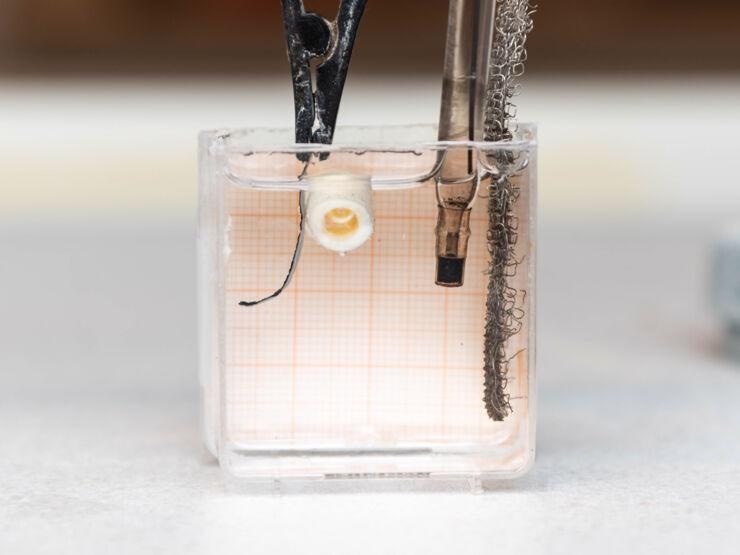During birth, humans have gaps in the skulls that are enclosed by pieces of soft connective tissue known as fontanelles. Thanks to the fontanelles, the human skull is able to deform at the time of birth and pass successfully via the birth canal. Following birth, the fontanelle tissue slowly turns to hard bone.
 When voltage is applied, the material (left) will slowly bend towards the chicken bone (white). If the liquid contains the minerals needed for bone development, the material will, in the space of a few days, begin to build artificial bone that attaches itself to the chicken bone. (Image Credit: Olov Planthaber).
When voltage is applied, the material (left) will slowly bend towards the chicken bone (white). If the liquid contains the minerals needed for bone development, the material will, in the space of a few days, begin to build artificial bone that attaches itself to the chicken bone. (Image Credit: Olov Planthaber).
At present, scientists have blended materials that together are similar to this natural process.
We want to use this for applications where materials need to have different properties at different points in time. Firstly, the material is soft and flexible, and it is then locked into place when it hardens. This material could be used in, for example, complicated bone fractures. It could also be used in microrobots – these soft microrobots could be injected into the body through a thin syringe, and then they would unfold and develop their own rigid bones.
Edwin Jager, Associate Professor, Department of Physics, Chemistry, and Biology (IFM), Linköping University
The notion was devised during a research visit in Japan when materials scientist Edwin Jager met Hiroshi Kamioka and Emilio Hara, who studied bones. The Japanese scientists had discovered a type of biomolecule that could trigger bone growth in a short span of time. Would it be feasible to unite this biomolecule with Jager’s materials research, to form new materials with variable stiffness?
In the study that ensued, published in Advanced Materials, the scientists engineered a kind of basic “microrobot”, one which can take up various shapes and modify stiffness. The scientists started with a gel material known as alginate. On one side of the gel, they grew a polymer material. This material is electroactive, and it alters its volume when a low voltage is supplied, making the microrobot bend in a particular direction.
On the other side of the gel, biomolecules that allow the soft gel material to harden were attached by the scientists. These biomolecules are derived from the cell membrane of a type of cell that is vital for bone development. When the material is soaked in a cell culture medium – an environment that is similar to the body and contains phosphor and calcium – the biomolecules mineralize the gel and turn it hard like bone.
One possible application of interest to scientists is bone healing. The plan is that the soft material, driven by the electroactive polymer, will be able to move into spaces in complex bone fractures and expand. When the material then becomes hard, it can form the basis for the construction of new bone.
In their research, the team showed that the material can bind itself around chicken bones, and the artificial bone that then forms grows together with the chicken bone.
By forming patterns in the gel, the team can establish how the basic microrobot will bend when voltage is supplied. The robot bends in a semicircle way when there are perpendicular lines on the material’s surface, while it bends like a corkscrew when diagonal lines are formed on the material.
By controlling how the material turns, we can make the microrobot move in different ways, and also affect how the material unfurls in broken bones. We can embed these movements into the material’s structure, making complex programmes for steering these robots unnecessary.
Edwin Jager, Associate Professor, Department of Physics, Chemistry, and Biology (IFM), Linköping University
With the intention of learning more about the biocompatibility of this mixture of materials, the scientists are currently exploring further into how its properties function together with living cells.
The study was performed with financial support from organizations including the Japanese Society for the Promotion of Science (JSPS) Bridge Fellowship program and KAKENHI, the Swedish Research Council, Promobilia and STINT (Swedish Foundation for International Cooperation in Research and Higher Education).
Journal Reference:
Cao, D., et al. (2021) Biohybrid Variable-Stiffness Soft Actuators that Self-Create Bone. Advanced Materials. doi.org/10.1002/adma.202107345.